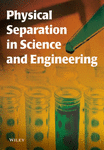Densimetric Separation of Coal Using Magnetic Fluids
Abstract
Ferrohydrostatic separation of particles in magnetic fluids is a sink-float technique based on generalized Archimedes law whereby, in addition to the conventional force of gravity, a magnetically induced force also acts on the fluid. This additional magnetic pull creates a magnetically induced buoyancy force on a particle immersed in the fluid. This buoyancy force can be accurately controlled over a wide range and particles as dense as 20 000 kg/m3 can be made to float. The selectivity of separation is very high and mixtures of particles with a density differential as small as 30 kg/m3 can be separated. As a result of the ability of FHS to separate material into narrow, well-defined density fractions, the technique is particularly suitable for densimetric analysis. Sink–float analysis of coal has been one of the areas of potential application of FHS. The cost of heavy liquids used for coal fractionation, and of their subsequent recovery and disposal are considerable and motivation to use FHS has therefore been strong. Numerous laboratory and pilot-plant scale tests have been conducted in this direction, particularly in Eastern Europe and Japan. Investigation of ash and sulphur content, and the mass yield into density fractions, confirmed that heavy liquid and FHS techniques are very similar in their performance. Very selective FHS separators with automated density control have recently been designed and built. A technique for the recovery of ferrofluids has been developed and low-cost ferrofluids are being manufactured on a production scale. Technology for accurate, environmentally friendly hands-off densimetric analysis of coal by is thus available




